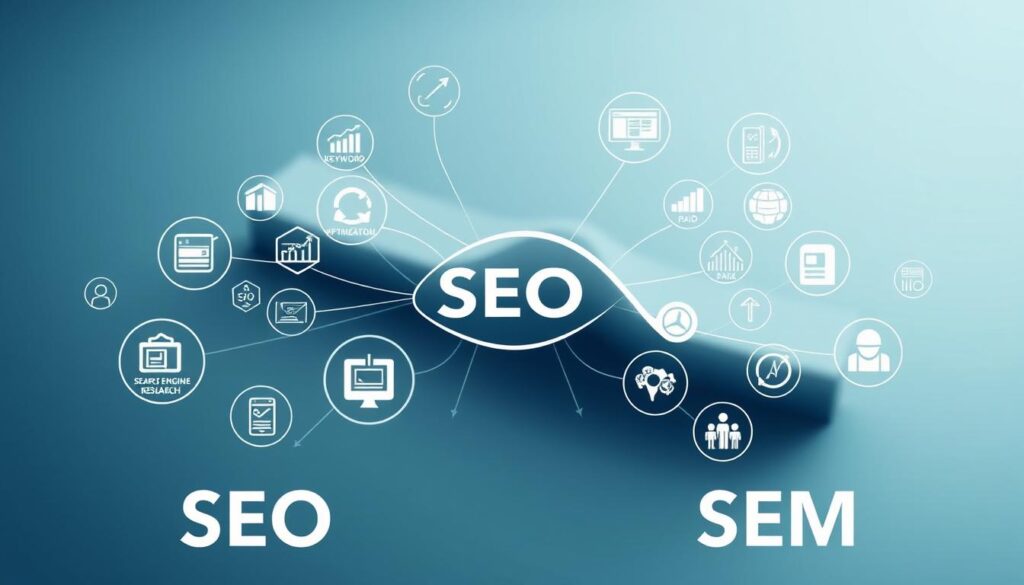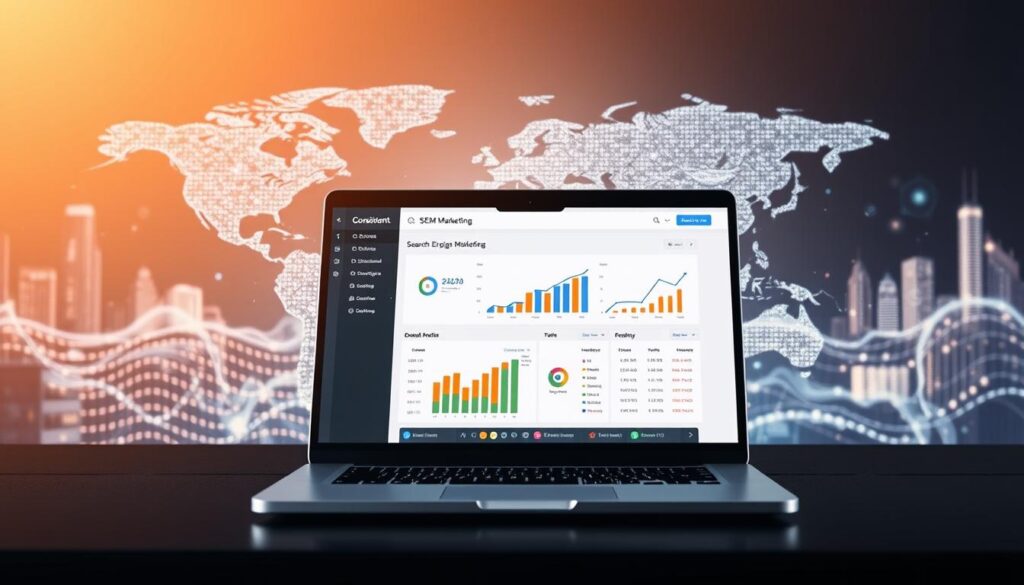In today’s competitive digital landscape, businesses need more than luck to stand out. Combining search engine optimization (SEO) with search engine marketing (SEM) creates a powerhouse strategy. While SEO builds long-term organic growth, SEM delivers instant visibility through paid ads. Together, they dominate search engine results, ensuring your brand reaches the right audience.
SEO focuses on improving your website’s technical setup, content quality, and user experience. This drives organic traffic from platforms like Google without direct costs. Meanwhile, SEM uses targeted ads to place your site at the top of search pages immediately. These paid campaigns work best when paired with keyword research and audience insights.
Why choose one when you can use both? Blending these strategies maximizes visibility across paid and unpaid results. Metrics like click-through rates (CTR) and cost-per-click (CPC) reveal what’s working. High-quality content and consistent branding keep users engaged, whether they find you through ads or organic listings.
Ready to dive deeper? Let’s explore how to build a seamless strategy that boosts traffic, conversions, and brand authority.
Key Takeaways
- SEO and SEM together cover both paid and organic search results for maximum visibility.
- SEO improves website structure and content to attract free, sustainable traffic.
- SEM uses paid ads to target specific audiences and deliver quick results.
- Metrics like CTR and CPC help measure the success of combined campaigns.
- Quality content and clear branding are critical for both strategies.
Overview of SEO and SEM in Digital Marketing
Digital success hinges on mastering two key strategies: SEO and SEM. Both play distinct roles in boosting online presence. Let’s break down their unique strengths.
Defining SEO and Core Techniques
Search engine optimization (SEO) improves website visibility through organic methods. On-page tactics include optimizing title tags, headers, and image alt text. Off-page efforts focus on building backlinks through guest posts or partnerships.
Quality content drives engagement. Blogs, guides, and videos keep users on your site longer. Technical fixes like mobile optimization and fast loading speeds also matter. These steps help pages rank higher on platforms like Google.
Understanding SEM’s Role in Online Visibility
Search engine marketing (SEM) uses paid ads for instant results. Platforms like Google Ads let businesses bid on keywords. Ads appear at the top of search pages, attracting clicks quickly.
SEM campaigns provide valuable data. Metrics reveal which keywords convert best. This information refines SEO strategies for long-term growth.
| Focus | SEO | SEM |
|---|---|---|
| Primary Goal | Sustainable traffic | Immediate clicks |
| Cost Structure | Time investment | Pay-per-click |
| Key Tools | Content, backlinks | Ad bids, extensions |
Combining both strategies covers all bases. SEO builds trust over time, while SEM fills gaps during slow periods. Together, they create a balanced digital marketing plan.
Understanding how seo and sem work together
Building a strong online presence requires both patience and precision. While organic methods lay the groundwork for lasting growth, paid tactics deliver quick wins. Combining these approaches creates a balanced strategy that dominates search engine results.

Organic vs. Paid Strategies
SEO acts like a marathon runner—steady, sustainable, and built for endurance. It strengthens site structure, refines content quality, and earns trust over months. For example, the first organic listing grabs a 28.5% click-through rate (CTR), outperforming paid ads at 10%.
SEM, meanwhile, sprints to the finish line. Paid campaigns place your brand atop search engine pages instantly. They’re ideal for product launches or seasonal promotions where timing matters.
Synergistic Benefits of Integration
Used together, these strategies create a feedback loop. Data from paid ads reveals high-converting keywords, which then inform SEO efforts. This alignment reduces wasted ad spend by up to 30% in some cases.
Consistent messaging amplifies results. Matching meta descriptions across organic listings and paid ads boosts brand recognition. Users clicking both see cohesive storytelling, deepening their connection to your brand.
Shared insights between teams unlock smarter decisions. When SEO and SEM collaborate, they identify gaps faster and allocate resources where they’ll shine brightest.
Foundations of SEO: Best Practices for Organic Growth
To thrive in search results, websites must balance technical optimizations with audience-focused tactics. This dual approach ensures lasting visibility while meeting user intent. Let’s explore the core elements that fuel sustainable growth.
On-Page and Off-Page Strategies
On-page efforts start with precise keyword placement. Title tags, headers, and meta descriptions should include target terms naturally. Optimize images by compressing files and adding descriptive alt text. A study found pages with properly tagged images attract 30% more clicks.
Off-page tactics build your site’s authority. Earn backlinks through guest posts on reputable industry sites. Social media shares and forum mentions also boost credibility. For example, a tech blog doubled its domain rating in six months by securing 50+ quality backlinks.
| On-Page Focus | Off-Page Focus |
|---|---|
| Meta tags optimization | Backlink acquisition |
| Content keyword density | Social signal cultivation |
| Image compression | Guest blogging |
Enhancing User Experience Through Quality Content
Fast-loading pages keep visitors engaged. Sites loading under two seconds see 35% lower bounce rates. Ensure mobile responsiveness—Google prioritizes mobile-friendly designs in rankings.
Create content that answers questions clearly. A health website increased organic traffic by 150% after rewriting articles to address specific user queries. Structure posts with subheadings and bullet points for easy scanning.
Regularly audit your website for broken links and outdated information. Tools like Google Search Console highlight performance gaps. Consistent updates signal freshness to search engines, boosting rankings over time.
Fundamentals of SEM: Driving Immediate Visibility
Speed matters in digital marketing. While organic growth takes time, search engine marketing (SEM) delivers fast-track results through paid campaigns. This approach uses platforms like Google Ads to place your brand above competitors instantly.

Effective Pay-Per-Click Tactics
PPC advertising thrives on strategic keyword selection. Focus on high-intent phrases like “buy running shoes” rather than generic terms. Tools like Keyword Planner help identify options with strong conversion potential but lower costs.
Bid adjustments maximize budget efficiency. Lower offers for broad matches and higher bids for exact phrases ensure ads reach the right audience. A clothing retailer increased sales by 40% using this method during holiday seasons.
Utilizing Ad Extensions for Improved Performance
Ad extensions turn basic listings into rich snippets. Add phone numbers, location pins, or product highlights. These elements boost credibility and CTR by up to 15% according to recent studies.
| Extension Type | Impact |
|---|---|
| Callout | +10% CTR |
| Sitelink | +20% engagement |
| Price | +12% conversions |
SEM works best as a temporary bridge while organic strategies mature. Track metrics like cost-per-acquisition weekly to refine campaigns. Pair these efforts with landing page optimizations for seamless user journeys.
Keyword Research and Data-Driven Strategy Alignment
Effective keyword research acts as the compass guiding both organic and paid search efforts. It uncovers what your audience seeks and how competitors target those needs. With tools like Data Cube and Instant, teams gain actionable insights to refine their approach.
Leveraging Analytical Tools for Competitor Insights
Analytics platforms reveal which terms rivals rank for organically and bid on in ads. For example, a travel agency discovered competitors focused on “budget vacations” but missed “affordable family travel packages.” Shifting their strategy to target this gap boosted organic clicks by 22% in three months.
High-performing keywords often share traits like clear search intent and moderate competition. Tools like Keyword Planner highlight metrics like monthly searches and difficulty scores. Pairing this data with on-page optimizations ensures content aligns with what users actually type into search bars.
Continuous monitoring keeps strategies agile. A tech brand noticed rising interest in “wireless home security systems” through SEM data. They updated blog content and product pages to match, doubling organic traffic for that term within six weeks.
Balancing short-term wins with long-term goals requires flexibility. Regular audits identify underperforming terms, allowing teams to reallocate budgets or tweak messaging. This cycle of testing and refining turns raw data into measurable growth.
Crafting Consistent Messaging Across SEO and SEM
Consistent messaging bridges the gap between organic and paid search efforts. When users see matching language in ads and website content, trust grows. Search engines reward this alignment with higher rankings, while audiences recognize your brand voice faster.

Coordinated meta descriptions and ad copy boost performance. For example, a study found aligned messaging increases click-through rates by 18%. Landing pages that mirror ad promises reduce bounce rates by 22%—users get what they expect.
| Element | SEO Impact | SEM Impact |
|---|---|---|
| Meta Descriptions | +15% CTR | +12% Quality Score |
| Headlines | Better keyword relevance | Higher ad relevance |
Regular team syncs prevent mixed signals. When SEO and SEM teams share keyword data monthly, campaigns become 30% more efficient. A fitness brand increased conversions by 25% after unifying calls-to-action like “Start Your Free Trial” across all touchpoints.
Clear CTAs drive action. Phrases like “Download Now” or “Get Pricing” perform best when repeated in:
- Paid ads
- Landing pages
- Blog posts
Data shows users need 5-7 brand exposures before converting. Unified messaging accelerates this process, turning casual searchers into loyal customers faster.
Leveraging Analytics for Continuous Improvement
Data drives modern marketing success. Tracking performance metrics helps teams spot trends and refine tactics. Tools like Google Analytics and Google Ads offer real-time insights into user behavior across organic and paid channels.
Monitoring Key Metrics: CTR, CPC, and Conversions
Focus on three core indicators. Click-through rate (CTR) shows ad relevance. Cost-per-click (CPC) measures budget efficiency. Conversion rates reveal how well pages turn visitors into customers.
| Metric | SEO Impact | SEM Impact |
|---|---|---|
| CTR | Indicates content appeal | Reflects ad copy quality |
| CPC | N/A (Organic) | Guides bid adjustments |
| Conversions | +15% with optimized CTAs | +25% with targeted landing pages |
Adjusting Campaigns with Data-Driven Insights
Weekly reviews prevent wasted spend. An e-commerce brand reduced CPC by 18% after shifting bids from low-performing keywords. They reallocated funds to high-converting terms identified through SEM data.
A/B testing refines messaging. Changing a headline from “Shop Now” to “Get 50% Off Today” boosted CTR by 12% in one campaign. Regular updates keep strategies aligned with audience needs.
Teams using shared dashboards make faster decisions. Unified data streams help identify gaps—like pages with strong traffic but low conversions. Fixing these issues improves overall visibility and ROI.
Integrating Organic and Paid Strategies for Maximum Visibility
Dominating search results requires both immediate impact and lasting growth. Combining organic and paid tactics creates a dual presence that captures attention while building credibility. This approach turns your brand into a familiar face across engine results pages.
Optimizing SERP Real Estate with Dual Presence
Showing up twice for the same keyword boosts visibility. Users who see your paid ads and organic listings perceive your brand as authoritative. A study found brands using both methods saw 40% higher click-through rates compared to single-channel efforts.
Strategies to maximize space without overspending:
- Bid on keywords where your site already ranks organically
- Use ad extensions to highlight reviews or special offers
- Align meta descriptions with ad copy for consistency
| Tactic | Organic Benefit | Paid Benefit |
|---|---|---|
| Shared Keywords | +22% CTR | +18% Conversions |
| Unified Messaging | Higher dwell time | Lower bounce rates |
Balancing Budget and Long-Term ROI
Allocate funds based on seasonal demand. During peak shopping periods, increase paid search bids for competitive terms. Shift focus to organic traffic building during slower months.
A home goods retailer reduced SEM spend by 35% while maintaining visibility. They achieved this by:
- Using SEO to rank for evergreen keywords
- Reserving paid ads for new product launches
- Sharing conversion data between marketing teams
This hybrid model delivers quick wins through ads while nurturing sustainable growth via content. Regular performance reviews ensure budgets adapt to market shifts and competitor moves.
Case Studies and Practical Examples of Unified Search Strategies
Seeing real results requires blending creativity with hard data. Brands that merge organic and paid tactics often outperform competitors. Let’s explore how unified strategies deliver measurable wins.
Real-World Success Stories from Digital Campaigns
A fitness apparel company boosted sales by 62% in six months. They optimized product pages for terms like “eco-friendly workout gear” while running Google Ads for seasonal promotions. Paid campaigns highlighted discounts, while organic content emphasized sustainability.
CTR rose 19% as ads and listings shared consistent messaging. Challenges included balancing budgets during peak demand. By analyzing conversion data weekly, they shifted funds to high-performing keywords without sacrificing visibility.
A travel agency doubled website traffic using SEM insights. Ads for “last-minute tropical vacations” revealed untapped keyword opportunities. They created blog guides around those terms, earning top organic rankings. Conversion rates jumped 28% within four months.
| Brand | Tactic | Result |
|---|---|---|
| Home Decor Retailer | Paid ads + SEO guides | +45% revenue |
| Tech Startup | Video ads + tutorials | +33% sign-ups |
Lessons from these campaigns:
- Align ad copy with landing page headlines
- Use paid metrics to refine organic keyword targets
- Schedule monthly team syncs to share insights
These examples prove integration isn’t optional—it’s essential. Start small, track progress, and scale what works for your audience.
Conclusion
Mastering digital visibility demands blending patience with precision. Organic strategies build lasting authority, while paid campaigns deliver instant impact. Together, they create a full-spectrum approach that dominates search engine results.
Combining SEO and SEM unlocks dual benefits. Sustainable website traffic grows through optimized content and technical tweaks. Paid ads fill visibility gaps during critical moments, like product launches. Data from both streams informs smarter budget decisions.
Continuous monitoring sharpens performance. Track metrics like click-through rates to refine messaging. Brands using unified strategies often see 30% higher engagement than single-channel efforts.
Ready to elevate your strategy? Start by auditing current campaigns. Align keywords across organic and paid efforts. Test ad copy that mirrors landing page headlines. Small tweaks today build tomorrow’s competitive edge.
Digital success isn’t about choosing between speed and stability—it’s about harnessing both. Build your presence brick by brick with SEO, then light it up with SEM’s spotlight effect.
